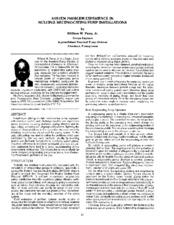| dc.contributor.other | International Pump Users Symposium (3rd : 1986) | |
| dc.creator | Parry, William W. | |
| dc.date.accessioned | 2017-10-05T22:41:12Z | |
| dc.date.available | 2017-10-05T22:41:12Z | |
| dc.date.issued | 1986 | |
| dc.identifier.uri | https://hdl.handle.net/1969.1/164340 | |
| dc.description | Lecture | en |
| dc.description | pg. 21 | en |
| dc.description.abstract | Installations utilizing multiple reciprocating pump equipped with common suction and discharge headers can experience severe problems including cavitation, piping vibration and fatigue failure, or destruction of pump components. Typically, the source of these problems is the interaction between naturally pulsating reciprocating pumps and the piping system. In the past, field testing was used to define the problems which were eliminated by trial and error methods, usually by installing suction and discharge dampeners or modifying system piping. However, advances in analytical techniques and data acquisition equipment have lead to better understanding of the system/pump relationship. This information is now available for use in designing reciprocating pump installations, thus eliminating the pulsation problems of the past. | en |
| dc.format.medium | Electronic | en |
| dc.format.mimetype | application/pdf | |
| dc.language.iso | en | |
| dc.publisher | Turbomachinery Laboratories, Department of Mechanical Engineering, Texas A&M University | |
| dc.relation.ispartof | Proceedings of the 3rd International Pump Symposium | en |
| dc.subject.lcsh | Pumping machinery | en |
| dc.title | System Problem Experience In Multiple Reciprocating Pump Installations | en |
| dc.type.genre | Presentation | en |
| dc.type.material | Text | en |
| dc.identifier.doi | https://doi.org/10.21423/R1WD74 | |


